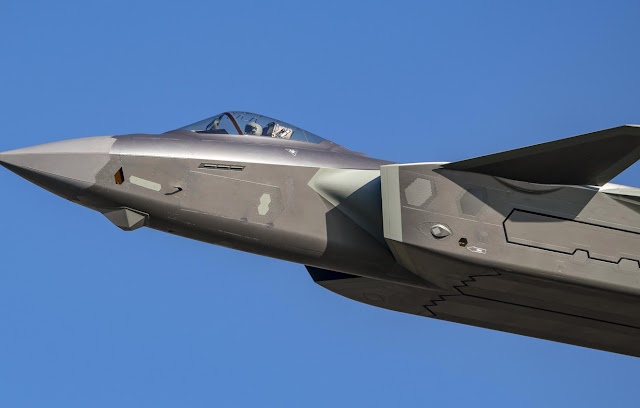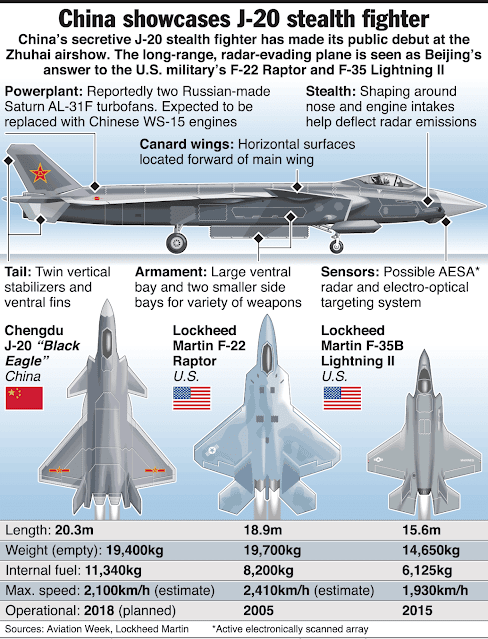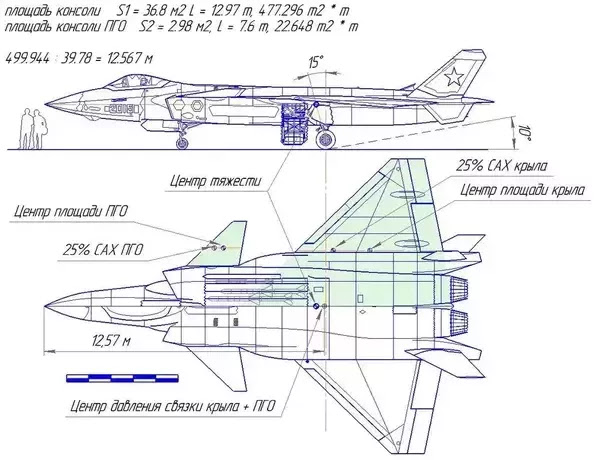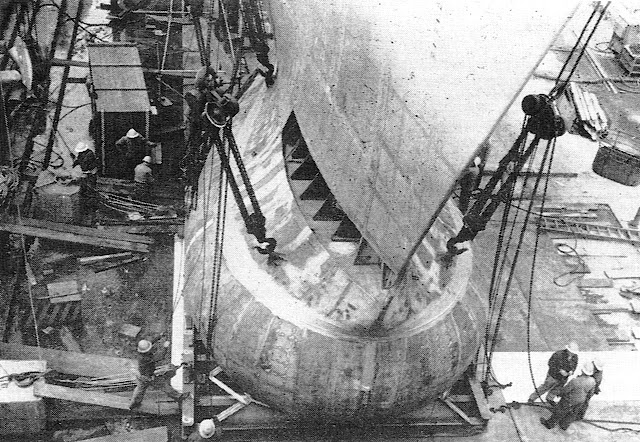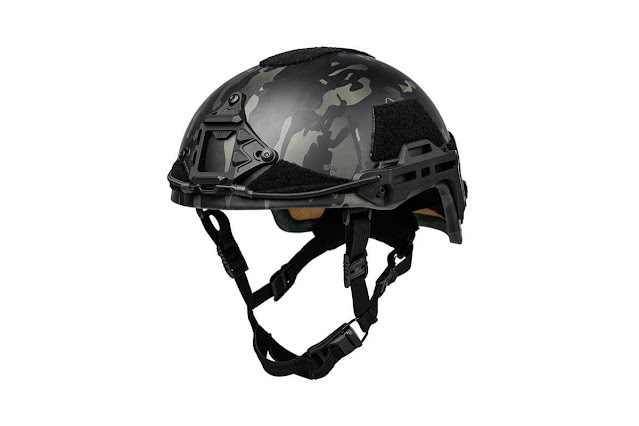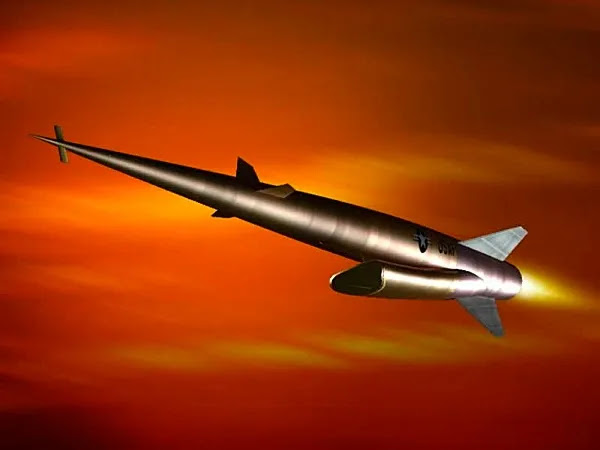Il Chengdu J-20 è un aereo da caccia stealth di quinta generazione sviluppato dall'azienda aeronautica cinese Chengdu Aircraft Industry Group negli anni duemila e dal 2016 in fase di preproduzione e introduzione in servizio operativo.
Panoramica
È un bireattore con configurazione alare delta canard con elevate caratteristiche di invisibilità, supercruise e maneggevolezza, complessivamente comparabile all'F-22. Il design dovrebbe trarre parzialmente ispirazione dal Mig 1.44 e dal Northrop-McDonnell Douglas YF-23 Black Widow II. Tra le caratteristiche innovative figurerebbero un radar AESA a scansione elettronica sviluppato localmente, una stiva interna, un'interfaccia digitale, un sistema di spinta vettoriale e una grande capacità di trasporto di armi e carburante in stive interne.
Dalle informazioni in possesso risulta che siano stati realizzati 9 prototipi (le cui foto sono apparse in rete il 22 dicembre 2010), e che si stanno effettuando numerosi test a terra; mentre sembra che il primo test in volo si sia tenuto l'11 gennaio 2011 sui cieli della città di Chengdu.
Anche il J-20 è attualmente equipaggiato con due turbofan di fabbricazione russa, anche se il caccia di linea dovrebbe essere dotato di un motore di concezione e produzione nazionale.
Per la propulsione, i cinesi puntano a sfruttare la tecnologia dei turbofan russi NPO Saturn AL-41F1 che equipaggiano i Su-35E (Pechino ne ha acquistati 24) per sviluppare un nuovo sistema propulsivo. Nonostante gli sforzi, i cinesi non hanno ancora sviluppato motori a reazione in grado di raggiungere le prestazioni dei Pratt & Whitney F119 e F135, che equipaggiano rispettivamente l’F-22 Raptor e l’F-35 Lightning della Lockheed Martin. Il J-20 non sarà in grado di raggiungere il suo pieno potenziale fino a quando la Cina non sarà in grado di sviluppare dei motori con un rapporto spinta-peso di dieci a uno. Provvisoriamente sono equipaggiati con dei turboreattori Saturn AL-31 di fabbricazione russa, a differenza del modello definitivo che monterà un propulsore di concezione e produzione nazionale denominato WS-15 accreditato di una spinta di 17 000 kgf, dotato di un ugello di spinta vettoriale tridimensionale e teoricamente capace di garantire al velivolo eccellenti prestazioni di supercrociera. Il J-20 dovrebbe trasportare internamente fino ad un massimo di quattro missili BVRAAM, beyond-visual-range air-to-air missiles e due a corto raggio PL-10.
Nel 2016 erano quattro i caccia J-20 operativi con numero di serie 2001, 2002, 2011 e 2017. I primi due, 2001 e 2002, sono stati utilizzati come dimostratori tecnologici mentre il 2011 ed il 2017 sono in configurazione di pre-produzione. A marzo 2017 i primi esemplari, con un anno di anticipo, sono entrati in servizio con la PLAAF, a confermarlo è stato il canale militare China Central Television.
Militare
Robert Gates ha minimizzato il valore del velivolo mettendo in dubbio quanto possa essere furtivo il J-20, ma ha dichiarato che il J-20 "metterebbe a rischio alcune delle nostre capacità, e dobbiamo prestare attenzione ad esse, dobbiamo rispondere in modo appropriato con i nostri programmi". Il direttore dei servizi segreti americani James R. Clapper ha testimoniato che gli Stati Uniti erano a conoscenza del programma da molto tempo e che il volo di prova non era una sorpresa.
Nel 2011, Loren B. Thompson, a cui fa eco un rapporto della RAND Corporation del 2015, ha ritenuto che la combinazione del J-20 di "forward stealth" e "long range" mette a rischio le risorse di superficie dell'America, e che una capacità di attacco marittimo a lungo raggio può causare agli Stati Uniti più preoccupazioni di un caccia a corto raggio da superiorità aerea come l'F-22. Nel suo rapporto annuale 2011 al Congresso, il Pentagono ha descritto il J-20 come "una piattaforma in grado di effettuare attacchi a lungo raggio, penetrando in ambienti di difesa aerea complessi". Un rapporto del 2012 della U.S.-China Economic and Security Review Commission suggerisce che gli Stati Uniti potrebbero aver sottovalutato la velocità di sviluppo del J-20 e di diversi altri progetti di sviluppo militare cinese.
Gli osservatori non sono riusciti a raggiungere un consenso sul ruolo primario del J-20. Sulla base delle fotografie iniziali con particolare attenzione alle dimensioni dell'aereo, le prime speculazioni si riferivano al J-20 come equivalente ad un F-111 con poca o nessuna capacità aria-aria. Altri vedevano il J-20 come un potenziale caccia di superiorità aerea una volta che fossero disponibili motori adeguati. Le speculazioni più recenti si riferiscono al J-20 come un caccia aria-aria con un'enfasi sulle capacità stealth, l'aerodinamica ad alta velocità, la portata e l'agilità adeguata. Il J-20 con il suo armamento missilistico a lungo raggio potrebbe minacciare aerorifornitori e piattaforme ISR/C2 come il Boeing KC-135 Stratotanker e il Boeing E-3 Sentry AWACS, privando Washington della copertura radar e del raggio d'azione. Tuttavia uno di questi obiettivi, il Northrop Grumman E-2D Advanced Hawkeye E-2D, è segnalato per essere ottimizzato per lo spotting di aerei stealth di dimensioni di caccia come il J-20.
Dopo l'annuncio dello schieramento, diversi analisti hanno notato che l'esperienza che la PLAAF guadagnerà con il J-20 darà alla Cina un vantaggio significativo su India, Giappone e Corea del Sud, che hanno faticato a progettare e produrre i propri caccia di quinta generazione nei tempi previsti. Tuttavia, nonostante il fallimento dei loro progetti indigeni, il Giappone e la Corea del Sud gestiscono gli F-35A importati, annullando questa potenziale disparità tecnologica. Il Corpo dei Marines degli Stati Uniti ha creato una replica in scala reale (FSR) di un J-20 di Chengdu nel dicembre 2018. La replica è stata vista parcheggiata fuori dall'Air Dominance Center all'aeroporto Savannah Hilton Head in Georgia. Il Corpo dei Marines degli Stati Uniti ha successivamente confermato che il velivolo era stato costruito per l'addestramento.
Controversia
Nell'aprile 2009, un rapporto del Wall Street Journal indicava che, secondo il Pentagono, le informazioni del Lockheed Martin F-35 Lightning II erano state compromesse da aggressori sconosciuti che sembravano provenire dalla Cina. Si ipotizza che il compromesso del programma F-35 possa aver contribuito allo sviluppo del J-20.
Operatori:
- Cina - Aeronautica Militare dell'Esercito di Liberazione del Popolo - 50 consegnati a partire da dicembre 2019. 9° Brigata Aerea, base aerea di Wuhu, Anhui.
Specifiche
Caratteristiche generali:
- Equipaggio: uno (pilota)
- Lunghezza: 20,4 m (66,8 ft)
- Apertura alare: 13,5 m (44,2 ft)
- Area dell'ala: 78 m2 (840 piedi quadrati)
- Peso a vuoto: 19.391 kg (42.750 lb)
- Peso lordo: 32.092 kg (70.750 lb)
- Peso massimo al decollo: 37.013 kg (81.600 lb)
- Capacità del carburante: 11.340 kg (25.000 lb) internamente
- Centrale elettrica: 2×Saturn AL-31FM2 turbofan postbruciatore, 145 kN (33.000 lbf) con postbruciatore.
Prestazioni:
- Velocità massima: Mach 2
- Portata: 6.000 km (3.700 mi, 3.200 nmi)
- Raggio di combattimento: 2.000 km (1.200 mi, 1.100 nmi)
- Soffitto di servizio: 20.000 m (66.000 ft)
- g limiti: +9/-3
- Velocità di salita: 304 m/s (59.800 ft/min)
- Caricamento delle ali: 340 kg/m2 (69 lb/sq ft)
- Spinta/peso: 0,92 (1,12 con peso a pieno carico e 50% di carburante) con AL-31FM2 (stimato).
Armamento
:
- Armi interne
- PL-10 a corto raggio AAM
- PL-12 AAM a medio raggio
- PL-15 BVR a lungo raggio AAM
- PL-21 AAM a lungo raggio
- LS-6 Bomba a guida di precisione
- Hardpoint esterni
- 4× tralicci sotto l'ala in grado di trasportare serbatoi di caduta.
Avionica
- Tipo 1475 (KLJ-5) matrice attiva a scansione elettronica
- Sistema di puntamento elettro-ottico EOTS-86 (EOTS)
- EORD-31 ricerca e traccia a infrarossi
- Sistema di apertura distribuita.
Utilizzatori
- Cina - Zhōngguó Rénmín Jiěfàngjūn Kōngjūn - 4 esemplari, 2 utilizzati come dimostratori tecnologici mentre 2 sono di pre-produzione. Al maggio 2018 sono 26 gli esemplari in servizio.
TAIWAN NEL MIRINO
Di recente R.I.D. riporta notizie di diverse fonti cinesi e taiwanesi sul fatto che Pechino avrebbe rischierato un numero imprecisato di caccia stealth J-20 dalla base aerea di Wuhu verso Quzhou, maggiormente vicina alla costa orientale cinese e a circa 500 km da Taiwan.
La difesa cinese conferma genericamente un continuo e regolare spostamento di velivoli e unità navali partecipanti ad un’esercitazione aeronavale a larga scala in corso dallo scorso 18 settembre nello stretto che separa la Cina da Taiwan.
L’attività in questione coinvolge diversi assetti aerei di fascia alta delle FA cinesi, tra cui apparecchi antisom Y-8Q, aerei AEW&C KJ-500 e velivoli da guerra elettronica Y-9.
Non è da escludere che il loro rischieramento, effettuato in pieno giorno nei pressi di un’area densamente popolata, possa rappresentare anche un messaggio d’avvertimento alla “provincia ribelle” ed al suo alleato statunitense dopo i recenti attriti.
La Cina dispone di oltre 40 J-20 operativi, la maggior parte dei quali assegnati alla 9ª Brigata di stanza a Wuhu.
ENGLISH
The Chengdu J-20 (Chinese: 歼-20; pinyin: Jiān-Èrlíng), also known as Mighty Dragon (Chinese: 威龙; pinyin: Wēilóng), is a single-seat, twinjet, all-weather, stealth, fifth-generation fighter aircraft developed by China's Chengdu Aerospace Corporation for the People's Liberation Army Air Force (PLAAF). The J-20 is designed as an air superiority fighter with precision strike capability; it descends from the J-XX program of the 1990s.
The J-20 made its maiden flight on 11 January 2011, and was officially revealed at the 2016 China International Aviation & Aerospace Exhibition. The aircraft entered service in March 2017, and began its combat training phase in September 2017. The first J-20 combat unit was formed in February 2018.
The J-20 is the world's third operational fifth-generation stealth fighter aircraft after the F-22 and F-35.
Development
The J-XX (Chengdu J-20) development program was started in the late 1990s. A proposal from Chengdu Aerospace Corporation, designated Project 718, won the PLAAF endorsement following a 2008 competition against a Shenyang proposal that was larger than the J-20.
In 2009, a senior PLAAF official revealed that the first flight was expected in 2010–11, with a service entry date by 2019. On 22 December 2010, the first J-20 prototype underwent high speed taxiing tests outside the Chengdu Aircraft Design Institute. Three months later, the first J-20 prototype made its maiden flight in Chengdu.
Several changes were made to J-20 prototypes, including new low-observable intake and stealth coating, as well as redesigned vertical stabilizers in 2014. Analysts noted new equipment and devices for multi-role operations such as integrated targeting pods for precision-guided munition, and six additional passive infrared sensors can also be spotted around the aircraft.[20] In December 2015, the low rate initial production (LRIP) version of J-20 had been spotted by a military observer.
Chinese state media reported in October 2017 that the designs of J-20 had been finalized, and is ready for mass production as well as combat-ready.
In January 2019, Chinese media reported that a twin-seat variant of the J-20 is rumored to be in development for use in tactical bombing, electronic warfare and carrier strike roles.
In November 2019, a J-20 painted in yellow primer coating was spotted during its flight testing by defense observers at the Chengdu Aerospace Corporation manufacturing facility. The aircraft is equipped with new variant of WS-10 Taihang engines with serrated afterburner nozzles to enhance stealth. Report indicated Chengdu Aerospace Corporation terminated the manufacturing of J-20 with Russian engines since mid-2019.
Chinese media reported that a new variant of the J-20, the J-20B, was unveiled on July 8, 2020 and entered mass production the same day. The only change mentioned was that the J-20B was to be equipped with thrust vectoring control. Conflicting reports emerged regarding the exact engine type. Analyst Andreas Rupprecht expressed skepticism regarding the use of Russian engine on J-20, as he believes that the J-20 is using a variant of the WS-10 which he called the WS-10C. This engine has improved thrust, stealthier serrated afterburner nozzles and higher reliability, but it is not designed for thrust vectoring unlike the WS-10 TVC demonstrated on a J-10 at the 2018 China International Aviation & Aerospace Exhibition. Analyst Jamie Hunter believed the new engine type is what he called WS-10B-3, a Chinese-made thrust vectoring engine demonstrated on the 2018 Zhuhai Airshow.
Design
Characteristics
The J-20 has a long and wide fuselage, with a chiseled nose section and a frameless canopy. Immediately behind the cockpit are low observable intakes. All-moving canard surfaces with pronounced dihedral are placed behind the intakes, followed by leading edge extensions merging into the delta wing with forward-swept trailing edges. The aft section has twin outward canted all-moving fins, short but deep ventral strakes, and conventional round engine exhausts.
One important design criterion for the J-20 is high instability. This requires sustained pitch authority at a high angle of attack, in which a conventional tail-plane would lose effectiveness due to stalling. On the other hand, a canard can deflect opposite to the angle of attack, avoiding stall and thereby maintaining control. A canard design is also known to provide good supersonic performance, excellent supersonic and transonic turn performance, and improved short-field landing performance compared to the conventional delta wing design.
Leading edge extensions and body lift are incorporated to enhance performance in a canard layout. This combination is said by the designer to generate 1.2 times the lift of an ordinary canard delta, and 1.8 times more lift than an equivalent sized pure delta configuration. The designer claims such a combination allows the use of a smaller wing, reducing supersonic drag without compromising transonic lift-to-drag characteristics that are crucial to the aircraft's turn performance.
Avionics and cockpit
Radar
Official information on the type of radar that J-20s use have not yet been released publicly. Some analysts believed that J-20s used Type 1475 (KLJ-5) active electronically scanned array (AESA) radar with 1856 transmit/receive modules, but more recent information's revealed that this radar was designed for upgraded versions of J-11D. Other analysts point out that, based on nose cross-section of J-20 and known data about a single transmit/receive module surface in the J-16's AESA radar-system, J-20s likely fit 2000–2200 transmit/receive modules.
Targeting and communication
Prototypes after application "2011" and production models feature revised nose section with an electro-optical/infra-red targeting system and an advanced communications suite on top of the aircraft enables it to datalink with other friendly platforms in service, such as airborne early warning drones. Six electro-optic sensors called Distributed Aperture System similar to EODAS can provide 360-degree coverage for pilot with sensor fusion system combining radar signal with IR image in order to provide better situational awareness. The combination of an integrated targeting pod with spherically located passive-optical tracking system is reported similar to the design concept of Lockheed Martin F-35's avionic suite. Beijing A Star Science and Technology has developed the EOTS-86 electro-optical targeting system and Electro-Optical Distributed Aperture System for the J-20 and potentially other PLAAF fighters to detect and intercept stealth aircraft.
Cockpit, helmet and displays
The aircraft features a glass cockpit, with one primary large color liquid crystal displays (LCD) touchscreen, three smaller auxiliary displays, and a wide-angle holographic head-up display (HUD). The size of the primary LCD screen is 24 x 9 inches (25.63 by the diagonal) with two systems for redundant illumination.
Armament
The main weapon bay is capable of housing both short and long-range air-to-air missiles (AAM; PL-9, PL-12C/D & PL-15 – PL-21) while the two smaller lateral weapon bays behind the air inlets are intended for short-range AAMs (PL-10). These side bays allow closure of the bay doors prior to firing the missile, thus allowing the missile to be fired in the shortest time possible as well as enhancing stealth. The J-20 is reported to lack an internal autocannon or rotary cannon, suggesting the aircraft is not intended to be used in short range dogfight engagements with other aircraft but engage them with from long standoff ranges with missiles such as the PL-15 and PL-21.
While the fighter typically carries weapons internally, the wings include four hardpoints to extend ferrying range by carrying auxiliary fuel tanks. However, much like the F-22, the J-20 is unlikely to carry fuel tanks on combat missions due to its vulnerability in such a configuration, thus this configuration remains valuable for peacetime operations, such as transiting between airbases. The fighter is able to carry four medium/long range AAMs in main bay and short-range missile one in each lateral weapon bay of the aircraft. A staggered arrangement with six PL-15s is possible depending on the rail launcher for missile mounted in the future.
Engines
The J-20 entered production powered by a Saturn AL-31 variant, reportedly the AL-31FM2 with a "special power setting" thrust of 145 kN (32,600 lbf).
The Shenyang WS-10 has also powered various aircraft. The WS-10B reportedly powered low rate initial production aircraft. The WS-10 may have replaced the AL-31 in mid-2019.
The intended powerplant is the Xian WS-15 with a thrust of 180 kN. The J-20 requires the WS-15 to supercruise. As of August 2019, the WS-15 was in development.
There are conflicting reports concerning the powerplant of the TVC-equipped J-20B. The powerplant has been identified as the AL-31FM2, or a variant of the WS-10; "WS-10C" by Andreas Rupprecht, or "WS-10B-3" by Jamie Hunter. The TVC-equipped WS-10B-3 was demonstrated at the 2018 China International Aviation & Aerospace Exhibition.
The aircraft is equipped with a retractable refueling probe embedded on the right side of the cockpit, to help the fighter to maintain stealth while flying greater distances.
Stealth
Analysts noted that the J-20's nose and canopy use a similar stealth shaping design as the F-22, yielding similar signature performance in a mature design at the front, while the aircraft's side and axi-symmetric engine nozzles may expose the aircraft to radar. One prototype has been powered by WS-10G engines equipped with different jagged-edge nozzles and tiles for greater stealth.
Others have raised doubts about the use of canards on a low-observable design, stating that canards would guarantee radar detection and a compromise of stealth. However, canards and low-observability are not mutually exclusive designs. Northrop Grumman's proposal for the U.S. Navy's Advanced Tactical Fighter (ATF) incorporated canards on a stealthy airframe. Lockheed Martin employed canards on a stealth airframe for the Joint Advanced Strike Technology (JAST) program during early development before dropping them due to complications with aircraft carrier recovery. McDonnell Douglas and NASA's X-36 featured canards and was considered to be extremely stealthy. Radar cross-section can be further reduced by controlling canard deflection through flight control software, as is done on the Eurofighter.
The diverterless supersonic inlet (DSI) enables an aircraft to reach Mach 2.0 with a simpler intake than traditionally required, and improves stealth performance by eliminating radar reflections between the diverter and the aircraft's skin. Analysts have noted that the J-20 DSI reduces the need for application of radar absorbent materials.
In May 2018, Indian Air Chief Marshal B.S. Dhanoa claimed that its Su-30MKI fighters could detect J-20 from "several kilometers away" amid reports from the Indian media that the J-20 was undetectable. Analyst Justin Bronk from Royal United Services Institute noted that Chinese are possibly flying the J-20 with radar reflectors during peacetime for safety and training purposes due to the potential for accidents and identification from other aircraft or ground installations.
Operational history
Flight testing
On 11 January 2011, the J-20 made its first flight, lasting about 15 minutes, with a Chengdu J-10B serving as the chase aircraft. After the successful flight, a ceremony was held, attended by the pilot, Li Gang, Chief Designer Yang Wei and General Li Andong, Deputy-Director of General Armaments. On 17 April 2011, a second test flight of an hour and 20 minutes took place. On 5 May 2011, a 55-minute test flight was held that included retraction of the landing gear.
On 26 February 2012, a J-20 performed various low-altitude maneuvers. On 10 May 2012, a second prototype underwent high speed taxiing tests, and flight testing that began later that month. On 20 October 2012, photographs of a new prototype emerged, featuring a different radome, which was speculated to house an AESA radar. In March 2013, images of the side weapon bays appeared, including a missile launch rail.
On 16 January 2014, a J-20 prototype was revealed, showing a new intake and stealth coating, as well as redesigned vertical stabilizers, and an Electro-Optical Targeting System. This particular aircraft, numbered '2011', performed its maiden flight on 1 March 2014 and is said to represent the initial pre-serial standard. By the end of 2014, three more pre-serial prototypes were flown: number '2012' on 26 July 2014, number '2013' on 29 November 2014 and finally number '2015' on 19 December 2014.
On 13 September 2015, a new prototype, marked '2016', began testing. It had noticeable improvements, such as apparently changed DSI bumps on the intakes, which save weight, complexity and radar signature. The DSI changes suggested the possibility of more powerful engines being used than on its predecessors, likely to be an advanced 14-ton thrust derivative of the Russian AL-31 or Chinese Shenyang WS-10 turbofan engines, though, by 2020 the J-20 is planned to use the 18–19 ton WS-15 engine, enabling the jet to super-cruise without using afterburners. The trapezoidal flight booms around the engines were enlarged, possibly to accommodate rearwards facing radars or electronic jamming equipment. The fuselage extends almost entirely up to the engine's exhaust nozzles. Compared to its "2014" and "2015" predecessors, the J-20's fuselage contains more of engine's surface area inside the stealthy fuselage, providing greater rear-facing stealth against enemy radar.
In November 2015, a new J-20 prototype, numbered '2017', took to the sky. The most significant change in the new prototype is the reshaped cockpit canopy, which provides the pilot with greater visibility. The lack of other design changes suggest that "2017" is very close to the final J-20 production configuration. Since '2017' is likely the last J-20 prototype, low rate initial production of the J-20 is likely to begin in 2016. It has been reported that the design of J-20 is already mature and will not directly use the 117S engine.
As of March 2017 there were still a series of technical problems that needed to be tackled, including the reliability of its WS-15 engines, the aircraft's flight control system, stealth coatings and hull materials, and infrared sensor.
Production
In late December 2015, a new J-20 numbered 2101 was spotted; it is believed to be the LRIP version of the aircraft.
In October 2017, Chinese media reported that Chengdu Aerospace Corporation (CAC) initiated a series production for the J-20 and is on a path towards achieving full operational capability with the People's Liberation Army Air Force (PLAAF). Initially, the lack of a suitable indigenously produced engine hindered the mass production of the J-20, however in September 2018, it was reported that issues with the development of the WS-15 engine, particularly the reliability of the turbine blades overheating at top speeds are fixed and after further minor refinements it should be ready for widespread installation by the end of 2018.
In 2019, Chengdu Aerospace Corporation began to manufacture J-20 fitted with Chinese-made WS-10 Taihang engine. J-20s manufactured after mid-2019 are no longer fitted with Russian AL-31F turbofan engines.
Deployment
At least six J-20s are in active service, with tail numbers 78271-78276 identified. Another six were believed ready to be delivered by end of Dec 2016. On 9 March 2017, Chinese officials confirmed that the J-20 had entered service in the Chinese air force. It is anticipated that before 2020 China be equipped with the Chengdu J-20 low observable combat aircraft. The International Institute for Strategic Studies (IISS) has proposed that the USA could lose its lead on operational stealth aircraft.
The J-20 officially entered service in September 2017 making China the second country in the world—after the United States—and the first in Asia to field an operational fifth-generation stealth aircraft.
The PLAAF began inducting J-20s into combat units in February 2018. The aircraft entered service with the 9th Air Brigade based at Wuhu Air Base, Anhui province in late 2018 – March 2019, replacing Su-30MKK fighters previously deployed there.
On 27 August 2019, the Central Military Commission of the People's Liberation Army have approved the J-20 as the PLAN's future primary fighter, beating out the FC-31. Arguments for the J-20 state that the plane is far more advanced, longer ranged and carries a heavier payload than the FC-31, while those supporting the FC-31 argued that it is cheaper, lighter and far more maneuverable than the J-20. It is likely that the J-20 would be commissioned upon the Type 002 aircraft carrier under construction, however, the length of the J-20 means that it has to be shortened to be considered operable on an aircraft carrier.
Training
Pilot training for the J-20 started as early as March 2017, after the fighter entered limited service in the initial operational capability (IOC) phase. During the IOC phase, the fighters equipped with radar reflectors, also known as Luneburg lens to enlarge and conceal the actual radar cross section.
The J-20 participated in its first combat exercise in January 2018, practicing beyond-visual-range maneuvers against China's fourth-generation fighters such as J-16 and J-10C. The exercise was reported to be realistic. Training with mixed generations allow pilots to become familiar with fifth-generation aircraft, and to develop tactics both for and against them. Chinese Ministry of National Defense also revealed that J-20 has conducted night confrontation missions during several coordinated tactical training exercises.
The J-20 participated in its first over-ocean combat exercise in May 2018.
Strategic implications
Political
The first test flight coincided with a visit by United States Secretary of Defense Robert Gates to China, and was initially interpreted by the Pentagon as a possible signal to the visiting US delegation. Speaking to reporters in Beijing, secretary Gates said "I asked President Hu about it directly, and he said that the test had absolutely nothing to do with my visit and there had been a pre-planned test." Hu seemed surprised by Gates' inquiry, prompting speculations that the test might have been a signal sent unilaterally by the Chinese military. Abraham M. Denmark of the Center for New American Security in Washington, along with Michael Swaine, an expert on the PLA and United States–China military relations, explained that senior officials are not involved in day-to-day management of aircraft development and were unaware of the test.
Military
Robert Gates downplayed the significance of the aircraft by questioning how stealthy the J-20 may be, but stated the J-20 would "put some of our capabilities at risk, and we have to pay attention to them, we have to respond appropriately with our own programs." The U.S. Director of National Intelligence James R. Clapper testified that the United States knew about the program for a long time and that the test flight was not a surprise.
In 2011, Loren B. Thompson, echoed by a 2015 RAND Corporation report, felt that J-20's combination of forward stealth and long range puts America's surface assets at risk, and that a long-range maritime strike capability may cause the United States more concern than a short range air-superiority fighter like the F-22. In its 2011 Annual Report to Congress, the Pentagon described the J-20 as "a platform capable of long range, penetrating strikes into complex air defense environments." A 2012 report by the U.S.‐China Economic and Security Review Commission suggests that the United States may have underestimated the speed of development of the J-20 and several other Chinese military development projects.
Observers were not able to reach a consensus on J-20's primary role. Based on initial photographs with focus on the aircraft's size, early speculations referred to the J-20 as an F-111 equivalent with little to no air-to-air ability. Others saw the J-20 as a potential air superiority fighter once appropriate engines become available. More recent speculations refer to the J-20 as an air-to-air fighter with an emphasis on forward stealth, high-speed aerodynamics, range, and adequate agility. The J-20 with its long range missile armament could threaten vulnerable tankers and ISR/C2 platforms such as the Boeing KC-135 Stratotanker and Boeing E-3 Sentry AWACS, depriving Washington of radar coverage and strike range. However one of these targets, the Northrop Grumman E-2D Advanced Hawkeye, is reported to be optimized for spotting fighter sized stealth aircraft such as the J-20.
After the deployment announcement, several analysts noted that experience that the PLAAF will gain with the J-20 will give China a significant edge over India, Japan, and South Korea, which have struggled to design and produce their own fifth-generation fighters on schedule. However, despite the failure of their indigenous projects, Japan and South Korea operate the imported F-35A, negating this potential technological disparity. United States Marine Corps created a full-scale replica (FSR) of a Chengdu J-20 in December 2018. The replica was spotted parked outside the Air Dominance Center at Savannah Hilton Head Airport in Georgia. The United States Marine Corps later confirmed that the aircraft was built for training.
Controversy
In April 2009, a Wall Street Journal report indicated that, according to the Pentagon, information from the Lockheed Martin F-35 Lightning II had been compromised by unknown attackers that appeared to originate from China. There is some speculation that the compromise of the F-35 program may have helped in the development of the J-20. See also here-below under Targeting and communication.
Operators:
- China - People's Liberation Army Air Force – 50 delivered as of December 2019. 9th Air Brigade, Wuhu Air Base, Anhui.
Specifications
General characteristics:
- Crew: one (pilot)
- Length: 20.4 m (66.8 ft)
- Wingspan: 13.5 m (44.2 ft)
- Wing area: 78 m2 (840 sq ft)
- Empty weight: 19,391 kg (42,750 lb)
- Gross weight: 32,092 kg (70,750 lb)
- Max takeoff weight: 37,013 kg (81,600 lb)
- Fuel capacity: 11,340 kg (25,000 lb) internally
- Powerplant: 2 × Saturn AL-31FM2 afterburning turbofan, 145 kN (33,000 lbf) with afterburner.
Performance:
- Maximum speed: Mach 2
- Range: 6,000 km (3,700 mi, 3,200 nmi)
- Combat range: 2,000 km (1,200 mi, 1,100 nmi)
- Service ceiling: 20,000 m (66,000 ft)
- g limits: +9/-3
- Rate of climb: 304 m/s (59,800 ft/min)
- Wing loading: 340 kg/m2 (69 lb/sq ft)
- Thrust/weight: 0.92 (1.12 with loaded weight and 50% fuel) with AL-31FM2 (estimated).
Armament:
- Internal weapon bays
- PL-10 short range AAM
- PL-12 Medium Range AAM
- PL-15 BVR long range AAM
- PL-21 Long Range AAM
- LS-6 Precision-guided bomb
- External hardpoints
- 4× under-wing pylon capable of carrying drop tanks.
Avionics:
- Type 1475 (KLJ-5) active electronically scanned array
- EOTS-86 electro-optical targeting system (EOTS)
- EORD-31 infrared search and track
- Distributed aperture system.
(Web, Google, Wikipedia, You Tube)





















